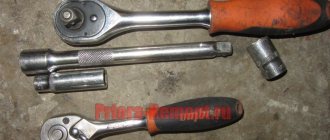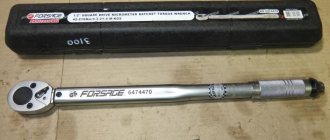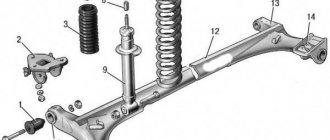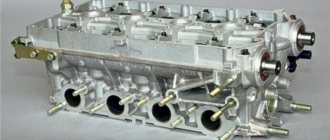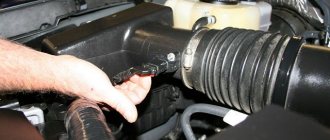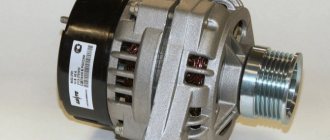Lada Priora was manufactured in the Russian Federation from 2007 to early 2022. After which, the model was discontinued due to the obsolescence of the modification.
For such a long stay on the market, Priora has become a worthy competitor to a number of European brands. In general, the workmanship and assembly quality of the model is at a decent level.
Breakdowns do happen, but they are minor and easily fixable. Subject to compliance with the requirements and recommendations of the manufacturer, the operating life of the machine exceeds 80 - 95 thousand km.
Summary data for Lada Priora (before restyling 2013)
The VAZ 2170 (this is exactly the indexing that Priora received) has an improved interior compared to the “ten”, a 16-valve engine with a volume of 1596 cc. see, and a 5-speed manual transmission in all trim levels (in the first trim levels of the sedan and hatchback with an 80 hp engine, an 8-valve engine was installed). In mixed driving mode, the Priora has 100 km. it takes from 6.6 to 7.6 liters. fuel outside the city (depending on the configuration), and in the city - 9.8 liters. The new engine allows you to accelerate to 180 km/h, and to “hundreds” in 12 seconds. This property attracts the attention of fans of high-speed racing, because by working on the engine and tuning the car, you can achieve good sports performance.
Technical improvements
Firmware or chip tuning
In order to improve the speed and agility of your car, you can flash the ECU of the Lada Priora for not very much money. This is done by qualified specialists. Using the firmware, you can customize the car as you wish, whether it is an economical car or a fast car.
Exhaust installation
As you know, a catalyst was installed on the Lada Priora. On cars with high mileage, it often gets clogged and fails, which slows down and slows down the car; replacing it is quite expensive. But there is a way out: replacing the exhaust with a spider without a catalyst. After replacing the catalyst with a spider. The Priora ECU will need to be re-flashed. For a more complete tuning of the Lada Priora exhaust, you can lay out the entire exhaust route. Which is not a cheap activity.
Replacing camshafts
Replacing camshafts with sports ones will increase the speed of the car and make it easier to accelerate and improve dynamics. Such work should be carried out in trusted service stations with subsequent adjustment of the electronic engine control unit.
Lightweight flywheel
Installing a lightweight flywheel will allow the engine to spin faster, thereby gaining speed faster. It was noted that when installing a lightweight one, the car has to move away at higher speeds.
Perforated brake discs
When replacing brake discs, it is best to immediately install perforated brake discs for the Lada Priora. These discs are very well ventilated, which allows them to heat up less and protects the pads from rapid wear.
Self-locking differential
A self-locking differential is installed in the gearbox, which allows both front wheels to spin simultaneously. As a result, a more reliable start from a place is ensured. Installing such a differential is quite difficult; the difficulty lies in adjusting it.
How much does Lada Priora weigh?
The weight of the car before restyling in 2013 was as follows:
- The 3-door hatchback coupe, 5-door hatchback and sedan have a curb weight (which includes the weight of a full tank of fuel and the driver) of 1088 kg. In this case, the total weight (i.e., the maximum permissible weight of the vehicle at which it can be operated after being fully loaded) is 1578 kg;
- The station wagon, with the same curb weight, is able to take a little more cargo, and its total weight reaches 1593 kg.
Thus, the station wagon is the most load-carrying of all Priora body types.
Factors on which the price depends
The cost of the body may vary. The price is formed under the influence of the following factors:
- Condition of the spare part.
- Availability of paint coating.
- Type of construction by shape.
- Equipment level.
- Originality.
- Place of purchase.
- The need for delivery and the cost of such a service.
- Implementer's pricing policy.
- Availability of documents for spare parts.
Body for Priora hatchback
How long does a gas tank last?
With the maximum filling of the gas tank, the Lada Priora, powered by AI-95 (according to the passport!) will travel:
- 438 km in the city;
- 767 km on the highway;
- 597 km combined cycle.
However, the driving range on a full tank is given by us as a rough estimate, since depending on the configuration and modification it may vary slightly, although in all cases the volume of the gas tank is the same: 43 liters.
Video from the car presentation
The article talks about the best-selling passenger car in Russia - the Lada Priora. Where did the Priora come from, how does it differ from its derivative (“tens”), what characteristics does it have, and how is it planned (and whether it is planned) to modify and improve the Priora further - answers about all this can be found in the presented article.
Lada Priora is a Russian-made front-wheel drive car, the best-selling model of the LADA family, produced by AvtoVAZ OJSC since 2007. According to the European classification it belongs to class “C”.
Cargo capacity
Cargo capacity (not payload!) of the Prior varies depending on the body type. So, trunks have different volumes:
- 360 liters – for hatchback and coupe;
- 430 liters - for the sedan;
- 444 liters - for the station wagon.
As we can see, this volume is not very different from the sedan’s, so it’s a very stretch to say that the Priora station wagon was created to solve a wide range of economic problems (relative to other variants of this car). Of course, cargo capacity increases significantly if you fold the back of the rear sofa, or even better, remove the entire rear seat.
Comfort 4
This package will cost 461 thousand rubles; it will repeat the previous one, but will include the following:
- Possibility to recline the rear seat back.
- A high-quality multimedia system that will have its own display with a diagonal of 7 inches. The display is touch-sensitive, protected from glare, the system supports the ability to connect to a mobile phone using Bluetooth, you can use Handsfree. Music playback is provided through a removable drive connected via USB, it has its own SD card, and you can listen to the radio. Only two speakers can be set.
Dimensions of VAZ 2170 and other modifications of Priora
The dimensions of the car are something that needs to be taken into account when purchasing, since the dimensions of parking spaces, garages, turns or entrance arches are not always universal. The height is measured from the extreme point of the front to the extreme point of the rear bumper. The width is measured at the widest point, and the height is measured from the surface of the ground to the highest point of the roof. Roof rails and racks do not fit into the height of the body. Taking this into account, the dimensions of the Priora are as follows:
- The longest body of cars in this family is the sedan. It measures 4350 mm in length. But at the same time it is the lowest - 1420 mm. in height.
- The next longest is the station wagon, with its 4340 mm length. It is the highest in height – 1508 mm.
- The five-door hatchback and three-door coupe are the shortest - 4210 mm. at 1435 mm. in height.
In all four cases, the width of the Priora is the same - 1680 mm. Ground clearance is 165 mm, although in the Priora Sport configuration it is somewhat reduced, but this is no longer so important, since this car is no longer produced in this version.
Main characteristics
| Brand | VAZ |
| Model | Lada Priora Hatchback |
| Modification | Lada Priora Hatchback 1.6 MT 98 hp |
| Model year | 2013 |
| Body type | Hatchback |
| Number of doors | 5 |
| Number of seats | 5 |
| Country of assembly | Russia |
Performance characteristics
| Type of fuel | AI-95 |
| Acceleration time to 100 km/h | 11.5 sec |
| Maximum speed | 183 km/h |
| Fuel consumption in the urban cycle | 9.1 l per 100 km |
| Fuel consumption on the highway | 5.5 l per 100 km |
| Combined fuel consumption | 6.9 l per 100 km |
| Power reserve | 473 – 782 km |
| Fuel costs per year (with a mileage of 100 km per day) | 119 629₽ |
| Transport tax * (Moscow) | 1 176₽ |
| OSAGO * (Moscow, age over 22 years, experience over 3 years) | 7 570₽ |
* Use Tax and OSAGO calculators for more detailed calculations.
Dimensions and dimensions
| Length | 4210 mm |
| Width | 1680 mm |
| Height | 1435 mm |
| Ground clearance | 165 mm |
| Front track | 1410 mm |
| Rear track | 1380 mm |
| Wheelbase | 2492 mm |
| Turning diameter | 11.6 m |
Weight
| Curb weight | 1163 kg |
| Full mass | 1578 kg |
| Load capacity | 415 kg |
Volumes
| Trunk volume | 360 l |
| Fuel tank volume | 43 l |
Engine
| engine's type | Petrol |
| Number of cylinders / arrangement | 4/Inline |
| Engine power, hp/rpm | 98/5600 |
| Engine displacement | 1596 cm³ |
| Torque, Nm/rpm | 145/4000 |
Transmission
| Drive unit | Front |
| Gearbox type | Mechanical, 5 gears |
Body
Modifications of Lada Priora until 2013
VAZ 2170 Lada Priora I generation cars have the following body options: 4-door sedan, 5-door hatchback and station wagon, and 3-door coupe. Depending on the year of manufacture and configuration, engine power may vary, which looks like this.
Engine Lada Priora 2007, sedan, 1st generation
Based on the configuration, sedans before the 2013 restyling are equipped with the following engines:
- 80 “horses”: 8 valves, maximum speed 172 km/h, gasoline consumption – 7.6 liters. for every 100 km. in a mixed cycle.
- 16-valve engine with 89 hp. reaches speeds of up to 176 km/h, consuming 7.3 l/100 km. paths in a mixed cycle. As you can see, in terms of its characteristics, this engine is not much different from its “younger brother,” although it consumes a little less gasoline.
- 16-valve 98-horsepower engine: maximum speed 183 km/h, AI-95 consumption in the combined cycle – 7.2 l/100 km.
Engine Lada Priora 2008, hatchback, 1st generation
5-door hatchbacks have been produced since 2008. Depending on the configuration, they are equipped with:
- 80-horsepower 8-valve engine, delivering the same speed and fuel consumption characteristics as in the case of a sedan equipped with the same engine;
- 16-valve engine with 89 hp, which produces the same speed for a hatchback and consumes the same amount of gasoline as a sedan with the same engine;
- A 98-horsepower 16-valve engine, thanks to which the hatchback completely matches the speed and consumption characteristics of a sedan with the same power plant.
Engine Lada Priora 2008, station wagon, 1st generation
With a station wagon everything is simpler. From the very beginning of production, it had only one, but the most powerful engine at that time, producing 98 l/s, which accelerated the car to 183 km/h and consumed 7.2 liters of gasoline per 100 km. paths in a mixed cycle. Thus, despite the large cargo capacity of the station wagon, its rated speed remains the same as that of other Priors in a different body version, but with the same engine, since the curb weight is the same for all modifications. Probably, when fully loaded, the station wagon will show slightly lower speed or higher fuel consumption characteristics.
Engine Lada Priora 2010, coupe, 1st generation
Since 2010, Priora has received another modification - a three-door coupe-hatchback. Everything with him is also quite simple, because... It is equipped with a 98-horsepower 16-valve engine, giving a top speed of 183 km/h, consuming 7.4 liters of gasoline per 100 km in the combined cycle, i.e. slightly more than all other body modifications. As you can see, the station wagon and coupe do not have such a wide engine variation as the 5-door hatchback and sedan, since cars of such a body are not designed for wide sale, but for specific needs: sports and motor tourism. By the way, the creators of Priora had the idea to launch a convertible into series, but reasonably considering that it would not find its buyer, they abandoned this idea.
Competitors of Lada Priora 2022 in a new body
When choosing a new car, you should not forget about competitors, who often have similar or superior characteristics. For Priora, the main competitors will be the following car models:
Among foreign models, there will most likely not be many competitors, since they belong to a different price category or are significantly superior to the Priora in terms of technical equipment. The closest competitors may be the following machines:
The Priora will perform well both in the city and on the highway thanks to the improved suspension and updated electronics.
Restyling Lada Priora 2013
The 2013 restyling consisted of some changes regarding the appearance, some equipment, interior and engine. Among such changes in Prior we will name:
- A slightly modified exterior geometry, which, however, makes no sense to describe, since visually Priora before and after restyling remained almost indistinguishable in appearance;
- Replacing the radiator grille with an elongated “honeycomb”, slightly tilting the car into the now fashionable “organic” style, characterized by biological forms;
- Improved external lighting technology, thanks to which the car’s dimensions have become clearer in the dark. In particular, the area of the reflectors has been increased, LED sections for side lights and brake lights have been added, which are both brighter and more responsive when switched on;
- A dashboard that is implemented differently: instead of four “dials,” the sensor arrows were arranged in two, without compromising functionality. Purely aesthetically it looks better, but from an ergonomic point of view, a lot depends on habit;
- An increased number of pictograms flashing on the dashboard, making it easier to figure out which lighting equipment is faulty;
- An added niche in the center of the dashboard, in which the on-board computer is placed;
- Extended front seat slides, allowing tall drivers and front passengers to adjust their seat positions more flexibly;
- A box that is more spacious in depth to the right of the driver;
- A more attractive three-spoke steering wheel with an airbag under a triangular cover;
- In the “luxury” configuration – leather upholstery based on a combination of auto fabric and eco-leather;
- New door card design.
Also, since 2013, Priors have been produced in a different engine configuration, from which the 80-horsepower engine was removed, but a new 106 l/s engine was added, which, like everyone else, reaches speeds of up to 183 km/h and reduces fuel consumption to 6. 8 – 6.9 liters per hundred km. This engine is equipped with the “luxury” configurations of the Priora. Of course, such a reduction in fuel consumption is very attractive to the consumer. We can only hope that the developers will continue to work in this direction. In addition, the new engine fits well into Euro-3 and Euro-4 environmental standards, thanks to the closely located catalyst. Due to rapid heating, the catalysis of toxic substances occurs more vigorously, as a result of which a lower concentration of them enters the atmosphere.
The restyled Prior also has a drawback (compared to previous editions of this car): the carpet in the trunk is thinner than its predecessors, which is why the noise level while driving is higher. Motorists are advised to take care of additional sound insulation in the trunk. In addition, the curb weight of the car has increased (to 1185 kg), which is by as much as 100 kg. reduced its cargo capabilities, since the maximum weight remained the same - 1593 kg. for a station wagon, and 1578 kg. for other body variations.
Image
The Image package is a little more expensive: its price will be 471,000 rubles. It will differ from the previously reviewed one in its interior, decorated in the Special Edition style. Other innovations:
- The wheels will be fitted with R15 alloy wheels, but a standard spare wheel will be provided.
- Perhaps the luxury version will be equipped with cruise control, but then the likelihood that the price will rise to 550,000 rubles is quite likely.
- The car can get parking sensors, rain and light sensors, and additional airbags.
Configurations of Lada Priora VAZ 2170 and other modifications
VAZ 2170 is known in the following configurations:
- “Standard” is the most budget package. It lacks: audio radio, speakers, air conditioning, rear headrests, immobilizer, central locking, heated front seats, electric drive and heated exterior mirrors, fog lights, remote trunk release. The front windows are electric, the rear windows are mechanical. The engine is 81 hp, which has been discontinued since 2013, and at the moment there are no longer orders for this configuration;
- “Norma”, which is equipped with an 87-, and after restyling - only a 98- and 106-power engine. Available: audio preparation, on-board computer, electric heating and electric drive of exterior mirrors, immobilizer, anti-theft alarm and all the elements of the “standard” equipment plus some new equipment. This configuration is in greatest demand due to its price niche. When you need a car “yesterday”, you have to buy what you have enough money for now, and everyone else has to retrofit the car in the process.
- "Norma+". In fact, this is the same standard for which one or more items of equipment are set: air conditioning, audio radio with speakers, ABS + BAS, child seat mounts, heated front seats and windshield;
- “Lux” is the most rich in functionality. It has everything that the “norm+” has, and in addition: side airbags, an airbag for the front passenger, rear and front electric windows, a navigator, a multimedia system, cruise control, parking sensors, fog lights, a rain sensor, a climate system , alloy wheels, heated front seats;
- “Sport” is a special package that increases the “sports” component. This is an aerodynamic body kit: a pronounced bumper with a spoiler, side sills, a diffuser rear bumper, and a wing on the trunk lid. The wheels with narrow profile tires are also different. Ground clearance, curb weight (up to 1080 kg) and maximum weight (up to 1500 kg) have been reduced. The interior has also been transformed: side supports have been added along the edges of the seats with red stitched seams, carbon fiber inserts, and a leather steering wheel. Air conditioning, radio, and a full set of electric windows are included. However, the production of sports Prioras was limited and today they are discontinued, although they can be found here and there on the highway, and most often these are Priora coupes.
Of course, this is not a complete, but only an indicative overview of the configurations of the Lada Priora, which is hardly possible to present in its entirety within the confines of one article. In addition, the equipment also differs somewhat depending on the body type. For example:
- Prior station wagons have roof rails, brackets on the wheel arches of the trunk, for which cargo can be strapped;
- For the coupe body, folding backrests and a reinforced frame of the front seats have been developed.
Standard
This is the basic package, the cost of which will be 387,000 rubles. It will include:
- One airbag provided for the driver's seat.
- ISOFIX child seat mounting system.
- ABS, EBD, BAS.
- Headrests.
- Signaling.
- Electric power steering.
- There will be no radio, only audio preparation.
- Front windows.
- Exterior mirrors will be heated and electrically driven.
- The seats are heated.
- Climate control can be installed for an additional fee.
- Discs are installed either R 13 or R 14.
- The Special Edition interior is available for an extra charge.
Suspension characteristics
The Priora's chassis was designed for smooth driving over bumps and obstacles, as well as driving along a country road. Of course, the VAZ-2170 is not an SUV, but it can easily go through many places. The front part of the suspension is independent, and the rear part is semi-independent, which makes the car softer.
Many owners almost immediately replace the anti-roll bar arms along with the struts with a sports kit - so that the car does not wobble when making a sharp turn. Telescopic shock absorbers consistently dampen vibrations when passing obstacles, so there will be no problems with it. VAZ-2170 is a front-wheel drive car.
- Front suspension is MacPherson type with longitudinal braces.
- The rear suspension is also with trailing arms. It has a U-shaped transverse beam, to which a torsion-type anti-roll bar is attached.
As for the ground clearance, for the pre-restyling version it was 165 mm, and for the restyled version it was 170 mm. The wheelbase is 249.2 cm, the front track width is 141 cm, the rear track is 138 cm. The suspension can be lowered or raised if desired - ready-made kits for modernization are available for open sale.
Brake system
The front and rear brakes are different. There are ventilated disc brakes with a single-piston floating caliper and automatic adjustment of the gap between the pads and the disc at the front, and drum brakes at the rear. The brake system is diagonal, dual-circuit, hydraulic. Equipped with a vacuum booster.
It is possible to work with the traction control system. You can also install disc brakes at the rear instead of standard drum brakes. The new braking system will also support ABS. The parking brake is manual, on a cable with drive of the rear wheels.

